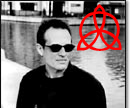

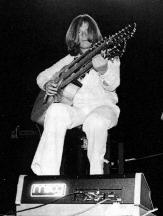 |
|
Playing "Ten Years Gone"
with the Moog pedals in 1977 (and his famous triple-neck!)
|
John Paul Jones unique combination of bass and keyboard talents was a great benefit to Led Zeppelin, but it made live performance somewhat difficult. Often, a song would be recorded with drums, guitar, and keyboard, but the bass would be overdubbed later. Performing these types of arrangements proved difficult live, as Jones would be playing the keyboards with both hands. To make the sound fuller, he often used various bass pedals, played with his feet.
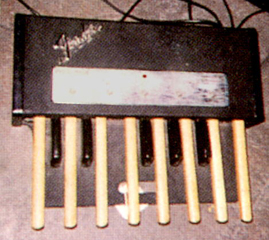 |
|
Early Fender bass pedals
|
These pedals were made by different companies, with slightly different sounds and features, but all based upon the same idea: the traditional organ pedal set has a standard piano keyboard, but made larger and longer to accomodate the feet. Typically, these pedal sets are only an octave or so long, which limits the player. They are almost always tuned to the low bass octave, although modern MIDI bass pedals allow any octave to be controlled. As Jones said in his 1977 Keyboard Magazine interview, "I also like instruments that you can play on your own without needing anybody else. The organ was always great for that because you didn't have to rely on some terrible bass player to try and follow you. Your pedals were there and all you needed was a drummer. I picked up on using bass pedals from playing in church." At one point in 1977, JPJ was touring with four sets of pedals onstage, so that he could play bass with his feet no matter which instrument he was playing.
Jones' first set of pedals were Fender bass pedals -- a set of organ-style pedals from the 1960s that were a portable octave of pedals that generated low bass tones. They could be set for immediate attack and release (as an organ-type tone) or a "string bass" sound that decayed away, instead of sustaining. Jones used Fender pedals for the only the early Led Zeppelin tours.
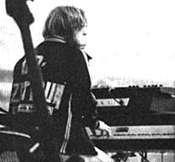 |
|
The control box for JPJ's Dunn
pedals
|
Jones' main pedal set was a custom-built unit, made by Bill Dunn of London. Dunn's organ service (particularly Hammond organs) was well-known in England and was the service center for the top rock, jazz, and pop stars of the day. Jones had Dunn build pedals that were very similar in tone to a Hammond bass pedal tone, but more mellow. His control box for the Dunn pedals would sit on top of the Fender Rhodes piano, and he was often seen adjusting the volume of the pedals during concerts. The Dunn control box has been a very recognizable part of JPJ's onstage rig. To most musicians, it was a mystery, as it was custom built and not obviously connected to the pedals below. The Dunn system was to remain even through the final Zeppelin concerts in 1980, where it sat prominently on the piano.
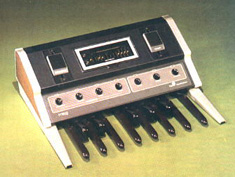 |
|
Moog Taurus pedals
|
For the 1975 Physical Graffiti tour and after, Jones would also use Moog Taurus pedals. The Moog pedals were similar to the others, only with a more powerful, flexible analog synthesizer attached. The pedals created a huge, heavy sound if needed, and were often featured while Jones played acoustic guitar during the famous acoustic sets. These pedals are now commonly called the "Taurus 1," because Moog issued a second set called "Taurus 2." Many feel the "Taurus 1" has better tone, while the "Taurus 2" has more features.